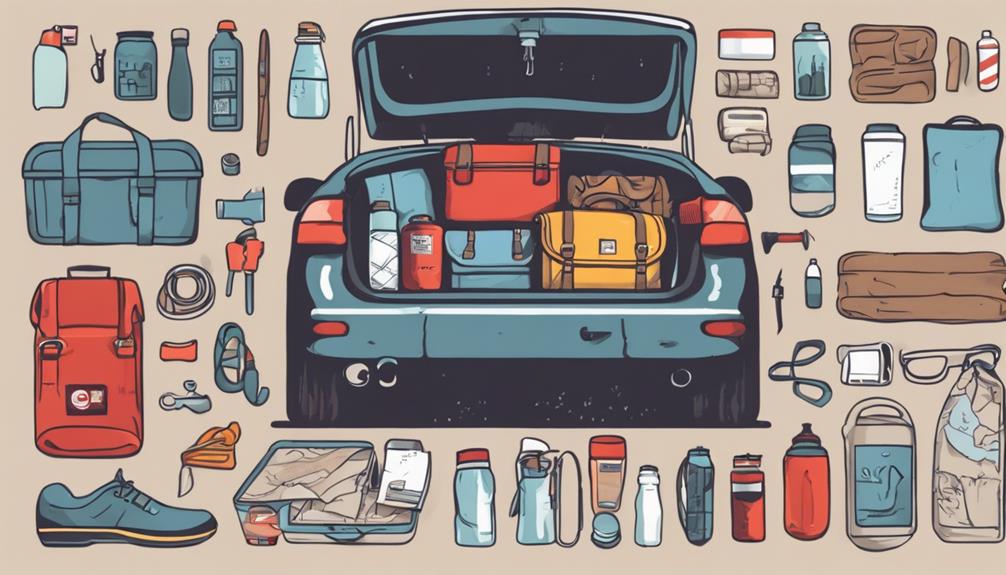What Are the Best Strategies for Stormy Road Trips?
Have you ever wondered if there are proven methods to navigate stormy road trips safely and efficiently?
When faced with unpredictable weather conditions, it becomes crucial to equip yourself with the knowledge and tools necessary to handle challenging situations on the road.
By implementing strategic planning and proactive measures, you can significantly increase your chances of reaching your destination unscathed.
From essential packing tips to crucial safety precautions, there are key strategies that can make all the difference when braving stormy weather during your journey.
Packing Essentials for Stormy Trips
When preparing for stormy road trips, ensure you pack essential items to stay safe and comfortable throughout your journey. One of the most important things to bring along is rain gear. This includes waterproof jackets, pants, and sturdy umbrellas to shield you from the rain and wind. Having proper rain gear will keep you dry and warm, allowing you to focus on driving without being distracted by the weather.
In addition to rain gear, make sure to pack emergency snacks. Stormy weather can sometimes lead to unexpected delays or road closures, leaving you stranded without access to food. Having non-perishable snacks like granola bars, nuts, or dried fruits on hand can help keep hunger at bay until you can reach a safe stopping point. It's also a good idea to pack extra water to stay hydrated during unforeseen circumstances.
Monitoring Weather Conditions
To stay informed and prepared for changing weather conditions, regularly check weather forecasts along your route. This simple step can help you anticipate any potential storms or adverse conditions that may lie ahead, allowing you to adjust your plans accordingly.
Here are some key tips to help you stay on top of the weather during your road trip:
- Sign Up for Weather Alerts: Register for weather alerts along your route to receive real-time updates on any severe weather conditions that may affect your journey.
- Pack a Weather Emergency Kit: Include essential items like extra blankets, non-perishable food, water, a flashlight, and a first aid kit in case you get stranded due to unexpected weather.
- Stay in Touch: Keep your phone charged and maintain communication with friends or family to update them on your whereabouts and any weather-related changes to your plans.
- Utilize Roadside Assistance Services: Be aware of roadside assistance options available along your route in case you encounter any weather-related vehicle issues.
- Plan Alternative Routes: Stay flexible by researching alternative routes in advance to avoid areas with severe weather warnings.
Safety Precautions During Storms
During stormy road trips, prioritize your safety by taking proactive measures to protect yourself and your vehicle. Before embarking on your journey, ensure you have access to weather alerts to stay informed about any potential storms along your route. It's crucial to stay updated on weather conditions to make well-informed decisions and potentially avoid driving in dangerous situations. Additionally, consider signing up for roadside assistance programs that can provide support in case of emergencies.
While on the road during a storm, maintain a safe following distance from other vehicles to allow for more reaction time in slippery conditions. Turn on your headlights to improve visibility for yourself and other drivers. If the rain becomes too heavy, pull over to a safe location and wait for the storm to pass. Avoid driving through flooded areas as water levels can be deceiving, and your vehicle may get stuck or swept away.
Remember to drive at a reduced speed during storms to minimize the risk of hydroplaning or losing control of your vehicle. Keep a firm grip on the steering wheel and stay focused on the road ahead. By taking these safety precautions and being prepared for stormy conditions, you can help ensure a safer and more manageable road trip experience.
Choosing the Right Route
Consider selecting a route that offers the shortest travel time and the least exposure to hazardous weather conditions. When embarking on a stormy road trip, the route you choose can significantly impact your safety and overall experience. Here are some tips to help you make the best decision:
- Check Real-Time Traffic Updates: Before hitting the road, use navigation apps or websites to check for traffic congestion and any road closures due to severe weather conditions.
- Utilize Weather Forecasting Tools: Keep an eye on weather forecasts along your planned route to anticipate any storms or adverse weather conditions that could affect your journey.
- Avoid High-Risk Areas: Steer clear of regions prone to flooding, landslides, or other weather-related hazards. Opt for alternative routes that minimize these risks.
- Consider Alternate Routes: Be prepared to adjust your route in real-time based on current weather conditions. Flexibility is key to avoiding dangerous situations.
- Plan for Rest Stops: Factor in regular breaks to rest and reevaluate your route if needed. Keeping a clear mind and staying refreshed is crucial for safe driving in stormy conditions.
Maintaining Safe Driving Speed
Ensure you adjust your driving speed appropriately to maintain safety in stormy weather conditions. Speed control is crucial when facing challenging weather. Reduce your speed to below the posted limits when road visibility is poor, and conditions are slippery. Sudden stops are riskier in wet weather, so maintaining a safe following distance and driving at a moderate speed gives you more time to react to any potential hazards.
Stay informed about weather updates along your route. Check weather forecasts before you start your journey and keep an eye on changing conditions during your trip. If severe weather is predicted, consider delaying your travel or finding a safe place to pull over until the storm passes.
Handling Hydroplaning Risks
To reduce the risk of hydroplaning on stormy roads, maintain proper tire tread depth and inflate your tires to the recommended level. Tire maintenance is crucial for preventing hydroplaning incidents.
Here are some key tips to help you handle hydroplaning risks effectively:
- Check Tire Tread Regularly: Ensure your tires have adequate tread depth to disperse water effectively and maintain traction on wet roads.
- Proper Tire Inflation: Keep your tires inflated to the manufacturer's recommended pressure to maximize tire contact with the road surface.
- Reduce Speed: Driving at a safe speed reduces the chances of hydroplaning, giving you more control over your vehicle in wet conditions.
- Avoid Sudden Movements: Gentle steering, braking, and acceleration can help prevent your vehicle from losing traction and sliding on wet roads.
- Practice Defensive Driving: Stay alert, keep a safe following distance, and be prepared for sudden stops or maneuvers to avoid potential hydroplaning situations.
Emergency Kit Preparation

Keeping an emergency kit in your vehicle is essential for handling unexpected situations on stormy road trips. Before embarking on your journey, ensure your emergency kit is well-stocked with essential supplies. Make sure to include items such as a flashlight, extra batteries, a first aid kit, non-perishable food, water, blankets, a multi-tool, and any necessary medication. These emergency supplies can be a lifeline in case you encounter any issues while on the road during a storm.
Regular vehicle maintenance is crucial to prevent breakdowns during stormy weather. Before setting off, check your vehicle's tires, brakes, lights, and windshield wipers to ensure they're in optimal condition. It's also important to have a full tank of gas before starting your journey and to keep it topped up throughout the trip, especially when bad weather might cause delays.
In addition to having emergency supplies and a well-maintained vehicle, it's wise to familiarize yourself with how to use the items in your emergency kit. Knowing how to change a tire, jump-start your vehicle, or use the tools in your kit can make a significant difference if you find yourself in a challenging situation. By being prepared with both emergency supplies and a well-maintained vehicle, you can navigate stormy road trips with confidence and peace of mind.
Seeking Shelter and Assistance
During stormy road trips, knowing where to seek shelter and how to get assistance can be crucial for your safety and well-being. Here are some tips to help you find help and stay safe:
- Local Authorities: Contact local authorities such as the police or fire department for immediate assistance in case of emergencies. They can provide guidance on the nearest shelters or safe areas.
- Gas Stations or Rest Stops: If you encounter a storm while on the road, seek refuge at nearby gas stations or rest stops. These locations often have staff who can help you during inclement weather.
- Hotels or Motels: Consider checking into a hotel or motel if the weather conditions become too severe to continue driving. Many accommodations offer discounted rates during storms.
- Shopping Centers: Large shopping centers or malls can also serve as temporary shelters during storms. You can wait out the bad weather inside until it's safe to resume your journey.
- Roadside Assistance: If your vehicle breaks down during a storm, contact your roadside assistance provider for help. They can dispatch a tow truck or mechanic to assist you, ensuring your safety on the road.
Frequently Asked Questions
How Can I Mentally Prepare for Driving in Stormy Conditions?
When bracing for stormy drives, you've got this! Mind over matter is key. Stay focused and calm. Build mental fortitude by visualizing a safe journey.
Prepare by checking weather updates and packing essentials. Stay alert, adjust speed, and keep a safe distance. Remember, your mindset influences your experience. Trust your skills and be cautious.
Drive confidently, knowing you're ready for whatever the weather brings. Stay safe out there!
Are There Any Specific Apps or Websites Recommended for Tracking Real-Time Weather Updates While on the Road?
When on stormy road trips, make sure to use apps or websites for real-time weather updates. These tools can provide crucial information about changing conditions.
Look for apps that offer emergency shelter locations and weather alerts to help you stay safe during your journey.
What Should I Do if I Encounter a Flooded Road While Driving During a Storm?
If you come across a flooded road while driving in a storm, prioritize safety. Avoid the water and turn around if possible. Don't risk driving through it.
Ensure your vehicle maintenance is up to date. Keep an emergency kit handy in case of any unexpected situations.
Stay informed about road conditions and weather updates to avoid such hazards during your road trip. Your safety is the top priority during stormy conditions.
Is It Recommended to Have a Backup Route Planned in Case of Road Closures or Severe Weather Conditions?
Having a backup route planned is crucial for unexpected road closures or severe weather conditions. Make sure to communicate your alternate routes with others and have emergency supplies on hand.
Regular vehicle maintenance is also key to ensure your car is ready for any conditions. By being prepared with alternate routes, communication, emergency supplies, and vehicle maintenance, you can navigate stormy road trips more safely and confidently.
How Can I Safely Navigate Through Strong Winds While Driving on the Highway During a Storm?
When driving on the highway during a storm with strong winds, ensure your safety by maintaining a steady speed and a firm grip on the wheel.
Look for emergency shelters along the route in case of sudden weather changes.
Opt for wind-resistant vehicles if possible.
Stay alert and avoid sudden maneuvers to prevent accidents.
Conclusion
In conclusion, when embarking on a stormy road trip, remember to pack essentials, monitor weather conditions, take safety precautions, choose the right route, maintain a safe driving speed, handle hydroplaning risks, prepare an emergency kit, and seek shelter and assistance when needed.
By following these strategies, you can ensure a safer and more enjoyable journey despite the stormy weather conditions.
Stay prepared and stay safe on the road!
